Question
B and C are subsets of a universal set U such that
\(U = \left\{ {x:x \in \mathbb{Z},0 \leqslant x < 10} \right\},{\text{ }}B = \left\{ {{\text{prime numbers}} < 10} \right\},{\text{ }}C = \left\{ {x:x \in \mathbb{Z},1 < x \leqslant 6} \right\}.\)
List the members of sets
(i) \(B\)
(ii) \(C \cap B\)
(iii) \(B \cup C′\)[4]
Consider the propositions:
p : x is a prime number less than 10.
q : x is a positive integer between 1 and 7.
Write down, in words, the contrapositive of the statement, “If x is a prime number less than 10, then x is a positive integer between 1 and 7.”[2]
Answer/Explanation
Markscheme
(i) \(B = 2, 3, 5, 7\) (A1)
Brackets not required
(ii) \(C \cap B = 2, 3, 5\) (A1)(ft)
Follow through only from incorrect B
(iii) \(C’ = 0, 1, 7, 8, 9\) (A1)(ft)
\(B \cup C’ = 0, 1, 2, 3, 5, 7, 8, 9\) (A1)(ft)
Note: Award (A1) for correct \(C’\) seen. The first (A1)(ft) in (iii) can be awarded only if C was listed incorrectly and a mark was lost as a result in (a)(ii). If C was not listed and \(C’\) is wrong, the first mark is lost. The second mark can (ft) within part (iii) as well as from (i). (C4)[4 marks]
“If x is not a positive integer between 1 and 7, then x is not a prime number less than 10.” (A1)(A1)
Award (A1) for both (not) statements, (A1) for correct order. (C2)[2 marks]
Question
You may choose from three courses on a lunchtime menu at a restaurant.
s: you choose a salad,
m: you choose a meat dish (main course),
d: you choose a dessert.
You choose a two course meal which must include a main course and either a salad or a dessert, but not both.
Write the sentence above using logic symbols.[2]
Write in words \(s \Rightarrow \neg d\) .[2]
Complete the following truth table.
 [2]
[2]
Answer/Explanation
Markscheme
\(m \wedge (s \underline{\vee} d)\) (A2)
(A1) for \(m \wedge \)
(A1) for \((s\underline{ \vee } d)\)
(A1)(A0) if brackets are missing.
OR
\((m \wedge s) \underline{\vee} (m \wedge d)\) (A2)
(A1) for both brackets correct, (A1) for disjunctive “or” (A1)(A0) if brackets are missing. (C2)[2 marks]
If you choose a salad then you do not choose a dessert. (A2)
(A1) for “if …then…” (A1) for salad and no dessert in the correct order.
OR
If you choose a salad you do not choose a dessert. (A2) (C2)[2 marks]

(A1) for each correct column (A1)(A1)(ft) (C2)[2 marks]
Question
Consider the following logic propositions:
\(p:{\text{ Sean is at school}}\)
\(q:{\text{ Sean is playing a game on his computer}}{\text{.}}\)
Write in words, \(p \underline { \vee } q\).[2]
Write in words, the converse of \(p \Rightarrow \neg q\).[2]
Complete the following truth table for \(p \Rightarrow \neg q\).
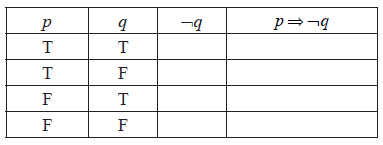 [2]
[2]
Answer/Explanation
Markscheme
Either Sean is at school or Sean is playing a game on his computer but not both. (A1)(A1) (C2)
Note: (A1) for ‘either … or but not both’ (A1) for correct statements. ‘Either’ can be omitted.[2 marks]
If Sean is not playing a game on his computer then Sean is at school. (A1)(A1) (C2)
Note: (A1) for ‘If … then’ (A1) for correct propositions in the correct order.[2 marks]
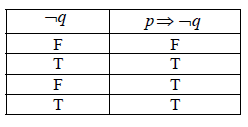 (A1)(A1)(ft) (C2)
(A1)(A1)(ft) (C2)
Note: (A1) for each correct column.[2 marks]
Question
Let \(p\) and \(q\) represent the propositions
\(p\): food may be taken into the cinema
\(q\): drinks may be taken into the cinema
Complete the truth table below for the symbolic statement \(\neg (p \vee q)\) .
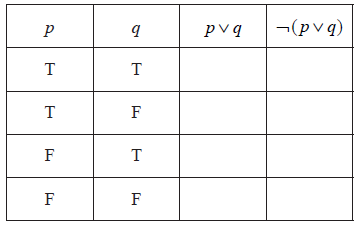 [2]
[2]
Write down in words the meaning of the symbolic statement \(\neg (p \vee q)\).[2]
Write in symbolic form the compound statement:
“no food and no drinks may be taken into the cinema”.[2]
Answer/Explanation
Markscheme
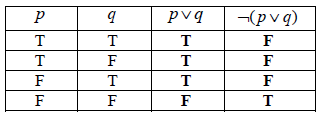 (A1)(A1)(ft) (C2)
(A1)(A1)(ft) (C2)
Note: (A1) for each correct column.[2 marks]
It is not true that food or drinks may be taken into the cinema.
Note: (A1) for “it is not true”. (A1) for “food or drinks”.
OR
Neither food nor drinks may be taken into the cinema.
Note: (A1) for “neither”. (A1) for “nor”.
OR
No food and no drinks may be taken into the cinema.
Note: (A1) for “no food”, “no drinks”. (A1) for “and”.
OR
No food or drink may be brought into the cinema. (A2) (C2)
Note: (A1) for “no”, (A1) for “food or drink”. Do not penalize for use of plural/singular.
Note: the following answers are incorrect:
No food and drink may be brought into the cinema. Award (A1) (A0)
Food and drink may not be brought into the cinema. Award (A1) (A0)
No food or no drink may be brought into the cinema. Award (A1) (A0)[2 marks]
\(\neg p \wedge \neg q\)
Note: (A1) for both negations, (A1) for conjunction.
OR
\(\neg (p \vee q)\) (A1)(A1) (C2)
Note: (A1) for negation, (A1) for \(p \vee q\) in parentheses.[2 marks]
Question
Complete the truth table shown below.
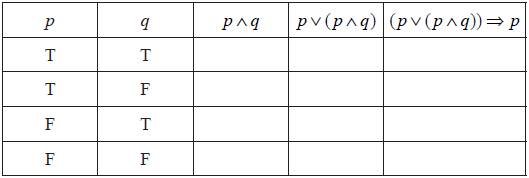 [3]
[3]
State whether the compound proposition \((p \vee (p \wedge q)) \Rightarrow p\) is a contradiction, a tautology or neither.[1]
Consider the following propositions.
p: Feng finishes his homework
q: Feng goes to the football match
Write in symbolic form the following proposition.
If Feng does not go to the football match then Feng finishes his homework.[2]
Answer/Explanation
Markscheme
 (A1)(A1)(ft)(A1)(ft) (C3)
(A1)(A1)(ft)(A1)(ft) (C3)
Note: Award (A1) for each correct column.[3 marks]
tautology (A1)(ft) (C1)
Note: Follow through from their last column.[1 mark]
\(\neg q \Rightarrow p\) (A1)(A1) (C2)
Note: Award (A1) for \(\neg q\) and p in correct order, (A1) for \( \Rightarrow \) sign.[2 marks]
Question
Complete the following truth table.
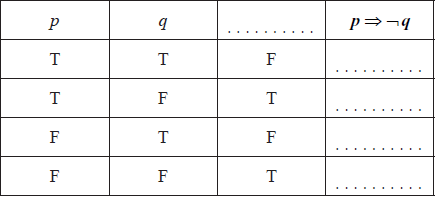 [2]
[2]
Consider the propositions
p: Cristina understands logic
q: Cristina will do well on the logic test.
Write down the following compound proposition in symbolic form.
“If Cristina understands logic then she will do well on the logic test”[2]
Write down in words the contrapositive of the proposition given in part (b).[2]
Answer/Explanation
Markscheme
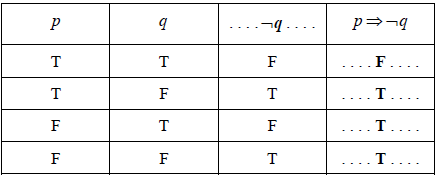 (A1)(A1) (C2)
(A1)(A1) (C2)
Note: Award (A1) for ¬q , (A1) for last column.[2 marks]
\(p \Rightarrow q\) (A1)(A1) (C2)
Note: Award (A1) for \(\Rightarrow\) , (A1) for p and q in the correct order.[2 marks]
If Cristina does not do well on the logic test then she does not understand logic. (A1)(A1) (C2)
Note: Award (A1) for If…(then), must be an implication, (A1) for the correct propositions in the correct order.[2 marks]
Question
Police in a town are investigating the theft of mobile phones one evening from three cafés, “Alan’s Diner”, “Sarah’s Snackbar” and “Pete’s Eats”.
They interviewed two suspects, Matthew and Anna, about that evening.
Matthew said:
“I visited Pete’s Eats and visited Alan’s Diner and I did not visit Sarah’s Snackbar.”
Let \(p\) , \(q\) and \(r\) be the statements:
\(p\) : I visited Alan’s Diner
\(q\) : I visited Sarah’s Snackbar
\(r\) : I visited Pete’s Eats
Write down Matthew’s statement in symbolic logic form.[3]
What Anna said was lost by the police, but in symbolic form it was
\[(q \vee r) \Rightarrow \neg p\]
Write down, in words, what Anna said.[3]
Answer/Explanation
Markscheme
\(r \wedge p \wedge \neg q\) (A1)(A1)(A1) (C3)
Note: Award (A1) for two conjunctions, (A1) for negation seen on \(q\), (A1) for correct compound statement.[3 marks]
If I visited (either) Sarah’s Snackbar or Pete’s Eats (then) I did not visit Alan’s Diner. (A1)(A1)(A1) (C3)
Note: Award (A1) for If\( \ldots \) (then), (A1) for Sarah’s Snackbar or Pete’s Eats, (A1) for did not visit Alan’s Diner.[3 marks]
Question
In a particular school, students must choose at least one of three optional subjects: art, psychology or history.
Consider the following propositions
a: I choose art,
p: I choose psychology,
h: I choose history.
Write, in words, the compound proposition
\[\neg h \Rightarrow (p \vee a)\].[3]
Complete the truth table for \(\neg a \Rightarrow p\) .
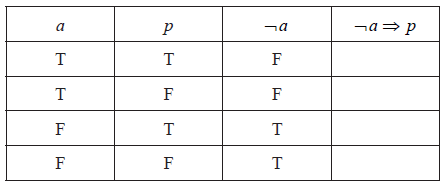 [1]
[1]
State whether \(\neg a \Rightarrow p\) is a tautology, a contradiction or neither. Justify your answer.[2]
Answer/Explanation
Markscheme
If I do not choose history then I choose either psychology or I choose art (A1)(A1)(A1) (C3)
Notes: Award (A1) for ‘if… (then)…’
Award (A1) for ‘not choose history.’
Award (A1) for ‘choose (either) psychology or art (or both).’
If the order of the statements is wrong award at most (A1)(A1)(A0).[3 marks]
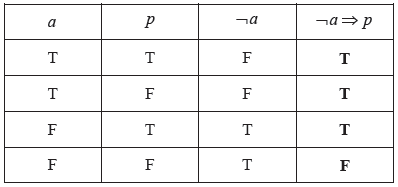 (A1) (C1)[1 mark]
(A1) (C1)[1 mark]
Neither, because not all the entries in the last column are the same. (A1)(ft)(R1) (C2)
Notes: Do not award (R0)(A1). Follow through from their answer to part (b). Reasoning must be consistent with their answer to part (b).[2 marks]
Question
Consider the statements
p : The numbers x and y are both even.
q : The sum of x and y is an even number.
Write down, in words, the statement p \(\Rightarrow\) q.[2]
Write down, in words, the inverse of the statement p \(\Rightarrow\) q.[2]
State whether the inverse of the statement p \( \Rightarrow \) q is always true. Justify your answer.[2]
Answer/Explanation
Markscheme
If (both) the numbers x and y are even (then) the sum of x and y is an even number. (A1)(A1) (C2)
Note: Award (A1) for If…(then), (A1) for the correct statements in the correct order.[2 marks]
If (both) the numbers x and y are not even (then) the sum of x and y is not an even number. (A1)(A1) (C2)
Notes: Award (A1) for If…(then), (A1) for the correct not p, and not q in the correct order. Accept the word odd for the phrase “not even”.[2 marks]
The inverse of a statement is not (necessarily) true, because two odd (not even) numbers, always have an even sum. (A1)(R1)(ft) (C2)
Notes: Award (A1)(R1) if a specific counter example given instead of a reason stated in general terms, e.g. the inverse is not true because, 5 and 7 have an even sum. Do not award (A1)(R0). Follow through from their statement in part (b).[2 marks]
Question
Consider the propositions p and q.
p: I take swimming lessons
q: I can swim 50 metres
Complete the truth table below.
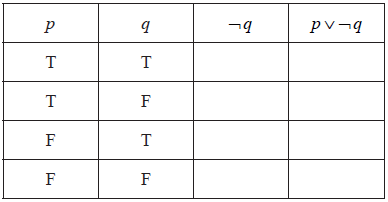 [2]
[2]
Write the following compound proposition in symbolic form.
“I cannot swim 50 metres and I take swimming lessons.”[2]
Write the following compound proposition in words.
\(q \Rightarrow \neg q \)[2]
Answer/Explanation
Markscheme
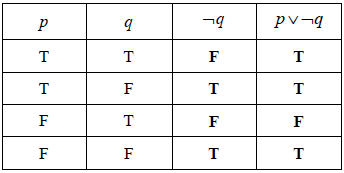 (A1)(A1)(ft) (C2)
(A1)(A1)(ft) (C2)
Notes: Award (A1) for each correct column. Follow through in 4th column from their 3rd column.[2 marks]
\(\neg q \wedge p\) (A1)(A1) (C2)
Note: Award (A1) for \(\neg q\) and p in any order, (A1) for \(\wedge\).[2 marks]
If I can swim 50 metres (then) I do not take swimming lessons. (A1)(A1) (C2)
Note: Award (A1) for If… (then), (A1) for correct propositions in the correct order.[2 marks]
Question
Consider the following logic statements.
p: Carlos is playing the guitar
q: Carlos is studying for his IB exams
Write in words the compound statement \(\neg p \wedge q\) .[2]
Write the following statement in symbolic form.
“Either Carlos is playing the guitar or he is studying for his IB exams but not both.”[1]
Write the converse of the following statement in symbolic form.
“If Carlos is playing the guitar then he is not studying for his IB exams.”[3]
Answer/Explanation
Markscheme
Carlos is not playing the guitar and he is studying for his IB exams. (A1)(A1) (C2)
Note: Award (A1) for “and”, (A1) for correct statements.[2 marks]
\(p\underset{\raise0.3em\hbox{$\smash{\scriptscriptstyle-}$}}{ \vee } q\) (A1) (C1)[1 mark]
\(\neg q \Rightarrow p\) (A1)(A1)(A1) (C3)
Notes: Award (A1) for implication, (A1) for the \(\neg q\), (A1) for both \(\neg q\) and \(p\) in the correct order. If correct converse seen in words only award (A1)(A1)(A0). Accept \(p \Leftarrow \neg q\). Accept \( – q\) for \(\neg q\).[3 marks]
Question
Consider the following logic propositions:
p : Yuiko is studying French.
q : Yuiko is studying Chinese.
Write down the following compound propositions in symbolic form.
(i) Yuiko is studying French but not Chinese.
(ii) Yuiko is studying French or Chinese, but not both.[3]
Write down in words the inverse of the following compound proposition.
If Yuiko is studying Chinese, then she is not studying French.[3]
Answer/Explanation
Markscheme
(i) \(p \wedge \neg q\) (A1)(A1)
Note: Award (A1) for conjunction, (A1) for negation of q.
(ii) \(p\underset{\raise0.3em\hbox{$\smash{\scriptscriptstyle-}$}}{ \vee } q\) OR \((p \vee q)\underset{\raise0.3em\hbox{$\smash{\scriptscriptstyle-}$}}{ \vee } (p \wedge q)\) (A1) (C3)
If Yuiko is not studying Chinese, (then) she is studying French. (A1)(A1)(A1) (C3)
Notes: Award (A1) for “if … (then)” seen, award (A1) for “not studying Chinese” seen, (A1) for correct propositions in correct order.
Question
Complete the truth table.
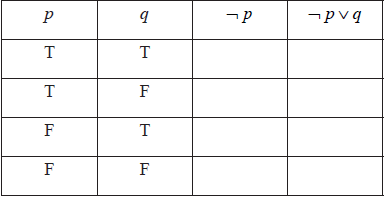 [2]
[2]
Consider the propositions p and q:
p: x is a number less than 10.
q: x2 is a number greater than 100.
Write in words the compound proposition \(\neg p \vee q\).[2]
Using part (a), determine whether \(\neg p \vee q\) is true or false, for the case where \(x\) is a number less than 10 and \(x^2\) is a number greater than 100.[1]
Write down a value of \(x\) for which \(\neg p \vee q\) is false.[1]
Answer/Explanation
Markscheme

(A1) for third column and (A1)(ft) for fourth column (A1)(A1)(ft) (C2)
\(x\) is greater than or equal to (not less than) 10 or \(x^2\) is greater than 100. (A1)(A1) (C2)
Note: Award (A1) for “greater than or equal to (not less than) 10”, (A1) for “or \(x^2\) is greater than 100”.
True (A1)(ft) (C1)
Note: Follow through from their answer to part (a).
Any value of \(x\) such that \( – 10 \leqslant x < 10\). (A1)(ft) (C1)
Note: Follow through from their answer to part (a).
Question
Consider the following propositions.
p : Students stay up late.
q : Students fall asleep in class.
Write the following compound proposition in symbolic form.
If students do not stay up late then they will not fall asleep in class.[2]
Complete the following truth table.
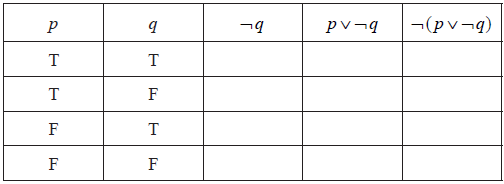 [3]
[3]
Write down a reason why the statement \(\neg ( p \vee \neg q)\) is not a contradiction.[1]
Answer/Explanation
Markscheme
\(\neg p \Rightarrow \neg q\) (A1)(A1) (C2)
Note: Award (A1) for any 2 correct symbols seen in a statement, (A1) for all 3 correct symbols in correct order.
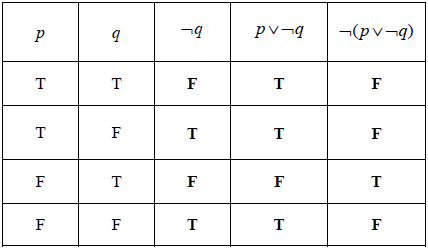 (A1)(A1)(ft)(A1)(ft) (C3)
(A1)(A1)(ft)(A1)(ft) (C3)
Note: Award (A1) for each correct column. 4th column is follow through from 3rd, 5th column is follow through from 4th.
Not all of last column is F (R1)(ft) (C1)
Note: Award (R1)(ft) if final column does not lead to a contradiction.
Question
Consider the propositions
\(p\): I have a bowl of soup.
\(q\): I have an ice cream.
Write down, in words, the compound proposition \(\neg p \Rightarrow q\).[2]
Complete the truth table.
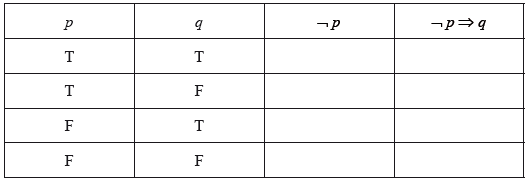 [2]
[2]
Write down, in symbolic form, the converse of \(\neg p \Rightarrow q\).[2]
Answer/Explanation
Markscheme
If I do not have a bowl of soup then I have an ice cream. (A1)(A1) (C2)
Notes: Award (A1) for If… then…
Award (A1) for correct statements in correct order.[2 marks]
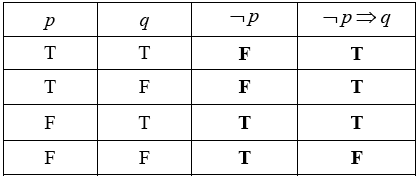 (A1)(A1)(ft) (C2)
(A1)(A1)(ft) (C2)
Note: Follow through from third column to fourth column.[2 marks]
\(q \Rightarrow \neg p\) (A1)(A1) (C2)
Notes: Award (A1) for \( \Rightarrow \).
Award (A1) for \(q\) and \(\neg p\) in correct order.
Accept \(\neg p \Leftarrow q\).[2 marks]
Question
Consider the three propositions p, q and r.
p: The food is well cooked
q: The drinks are chilled
r: Dinner is spoilt
Write the following compound proposition in words.
\[(p \wedge q) \Rightarrow \neg r\][3]
Complete the following truth table.
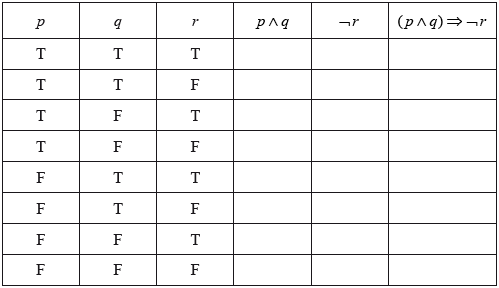 [3]
[3]
Answer/Explanation
Markscheme
If the food is well cooked and the drinks are chilled then dinner is not spoilt. (A1)(A1)(A1) (C3)
Note: Award (A1) for “If…then” (then must be seen), (A1) for the two correct propositions connected with “and”, (A1) for “not spoilt”.
Only award the final (A1) if correct statements are given in the correct order.[3 marks]
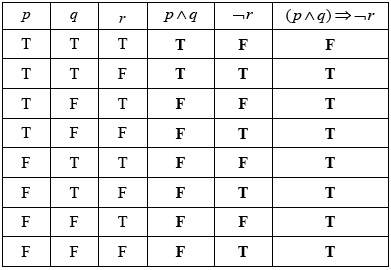 (A1)(A1)(A1)(ft) (C3)
(A1)(A1)(A1)(ft) (C3)
Notes: Award (A1) for each correct column.
The final column must follow through from the previous two columns.[3 marks]
Question
Two propositions are defined as follows:
\(p:\) Quadrilateral ABCD has two diagonals that are equal in length.
\(q:\) Quadrilateral ABCD is a rectangle.
Express the following in symbolic form.
“A rectangle always has two diagonals that are equal in length.”[2]
Write down in symbolic form the converse of the statement in (a).[1]
Determine, without using a truth table, whether the statements in (a) and (b) are logically equivalent.[2]
Write down the name of the statement that is logically equivalent to the converse.[1]
Answer/Explanation
Markscheme
\(q \Rightarrow p\) (A1)(A1) (C2)
Note: Award the first (A1) for seeing the implication sign, the second (A1) is for a correct answer only. Not using the implication earns no marks.[2 marks]
\(p \Rightarrow q\) (A1)(ft) (C1)
Note: Award (A1)(ft) where the propositions in the implication in part (a) are exchanged.[1 mark]
Not equivalent; a kite or an isosceles trapezium (for example) can have diagonals that are equal in length. (A1)(R1) (C2)
Notes: Accept a valid sketch as reasoning.
If the reason given is that a square has diagonals of equal length, but is not a rectangle, then award (R1)(A0).
Do not award (A1)(R0).
Do not accept solutions based on truth tables.[2 marks]
Inverse (A1) (C1)
Note: Do not accept symbolic notation.[1 mark]
Question
Two propositions \(p\) and \(q\) are defined as follows
\(p\): Eva is on a diet
\(q\): Eva is losing weight.
Write down the following statement in words.
\[q \Rightarrow p\][2]
Write down, in words, the contrapositive statement of \(q \Rightarrow p\).[2]
Determine whether your statement in part (a) is logically equivalent to your statement in part (b). Justify your answer.[2]
Answer/Explanation
Markscheme
If Eva is losing weight then Eva is on a diet (A1)(A1) (C2)
Notes: Award (A1) for If… then…
For Spanish candidates, only accept “Si” and “entonces”.
For French candidates, only accept “Si” and “alors”.
For all 3 languages these words are from the subject guide.
Award (A1) for correct propositions in correct order.[2 marks]
If Eva is not on a diet then she is not losing weight (A1)(A1) (C2)
Notes: Award (A1) for “not on a diet” and “not losing weight” seen, (A1) for complete correct answer.
No follow through from part (a).[2 marks]
The statements are logically equivalent (A1)(ft)
The contrapositive is always logically equivalent to the original statement (R1)(ft)
OR
A correct truth table showing the equivalence (R1)(ft) (C2)
Note: Follow through from their answers to part (a) and part (b).[2 marks]
Question
Consider the statement \(p \Rightarrow q\).
If I break my arm, then it will hurt.
Write down in words, the inverse of \(p \Rightarrow q\).[2]
Complete the following truth table.
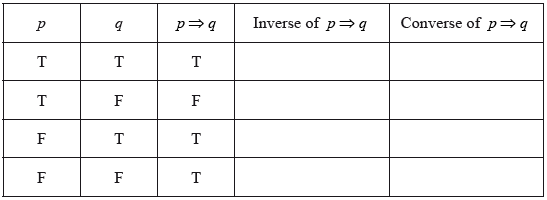 [2]
[2]
State whether the converse and the inverse of an implication are logically equivalent.
Justify your answer.[2]
Answer/Explanation
Markscheme
If I do not break my arm, then it will not hurt (A1)(A1) (C2)
Note: Award (A1) for “if… then…”
For Spanish candidates, only accept “Si” and “entonces”.
Award (A1) for “not break my arm” and “not hurt” in correct order.

(A1)(A1) (C2)
Notes: Award (A1) for each correct column.
logically equivalent (A1)(ft)
last two columns of the truth table are identical (R1)(ft) (C2)
Notes: Do not award (A1)(ft)(R0).
Follow through from the last two columns of the table in part (a).
Question
\(p:x\) is a multiple of \(12\)
\(q:x\) is a multiple of \(6\).
Write down in words \(\neg p\).[1]
Write down in symbolic form the compound statement
\(r:\) If \(x\) is a multiple of \(12\), then \(x\) is a multiple of \(6\).[2]
Consider the compound statement
\(s:\) If \(x\) is a multiple of \(6\), then \(x\) is a multiple of \(12\).
Identify whether \(s:\) is the inverse, the converse or the contrapositive of \(r\).[1]
Consider the compound statement
\(s:\) If \(x\) is a multiple of \(6\), then \(x\) is a multiple of \(12\).
Determine the validity of \(s\). Justify your decision.[2]
Answer/Explanation
Markscheme
\(x\) is not a multiple of \(12\) (A1) (C1)
\(p \Rightarrow q\) (A1)(A1)(C2)
Note: Award (A1) for \( \Rightarrow \), (A1) for \(p\) and \(q\) in the correct order.
Accept \(q \Leftarrow p\).
Converse (A1) (C1)
not valid (A1)
for example \(18\) is a multiple of \(6\) and not a multiple of \(12\) (R1) (C2)
Notes: Do not award (A1)(R0). Any multiple of 6 that is not a multiple of \(12\) can be accepted as a counterexample.
Question
Consider the following propositions.
\[\begin{array}{*{20}{l}} {p{\text{: The car is under warranty}}} \\ {q{\text{: The car is less than 2 years old}}} \\ {r{\text{ : The car has been driven more than 20}}\,{\text{000 km}}} \end{array}\]
Write down in words \((q \vee \neg r) \Rightarrow p\).[3]
Complete the truth table.
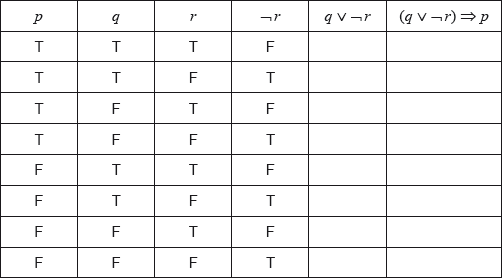 [2]
[2]
State whether the statement \(\neg p \Rightarrow \neg (q \vee \neg r)\) is the inverse, the converse or the contrapositive of the statement in part (a).[1]
Answer/Explanation
Markscheme
if the car is less than 2 years old or the car has not been driven more than \(20\,000{\text{ km}}\), then the car is under warranty (A1)(A1)(A1) (C3)
Note: Award (A1) for if …, then …, (A1) for “or”, (A1) for correct statements in correct order. Accept “If the car has not been driven more than \(20\,000{\text{ km}}\) or the car is less than 2 years old, then the car is under warranty”. Accept logical equivalent wording for each proposition, eg “less than \(20\,000{\text{ km}}\)”.[3 marks]
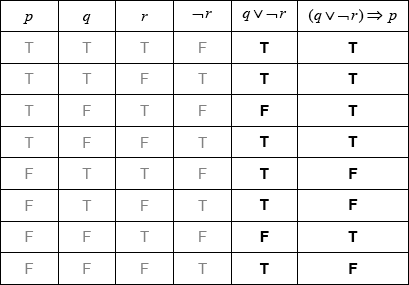 (A1)(A1)(ft) (C2)
(A1)(A1)(ft) (C2)
Note: Award (A1) for \(q \vee \neg r\) column correct and (A1)(ft) for \((q \vee \neg r) \Rightarrow p\) column correct. Follow through from their \(q \vee \neg r\) column.[2 marks]
contrapositive (A1) (C1)[1 mark]
Question
Consider the following propositions.
p : the baby cries
q : the baby is happy
r : the baby wants to play
Write down, in words, \(\left( {q \wedge r} \right) \Rightarrow \neg p\).[3]
Complete the following truth table.
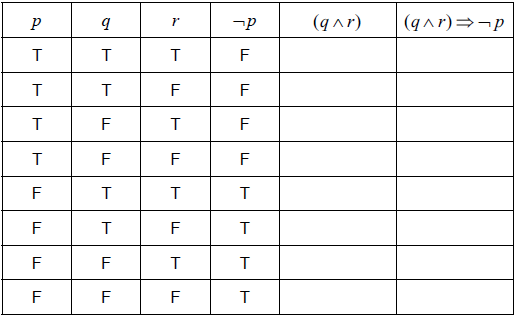 [2]
[2]
State whether \(\left( {q \wedge r} \right) \Rightarrow \neg p\) is a tautology, contradiction or neither.[1]
Answer/Explanation
Markscheme
if the baby is happy and wants to play then the baby does not cry (A1)(A1)(A1) (C3)
Note: Award (A1) for “If… then…”; (A1) for “the baby is happy and wants to play”, (A1) for “the baby does not cry”. Crying must be negated.[3 marks]
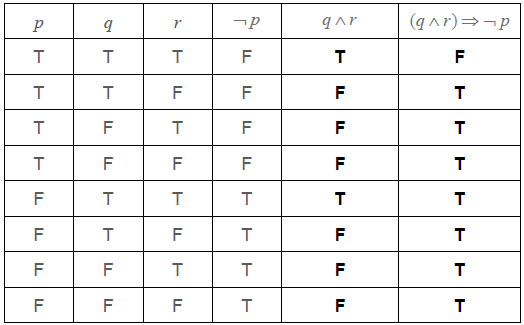 (A1)(A1) (C2)
(A1)(A1) (C2)
Note: Award (A1) for each correct column.[2 marks]
Neither (A1)(ft) (C1)
Note: Follow through from the last column in their part (b).[1 mark]
Question
Consider each of the following statements
\[p:Alex{\text{ }}is{\text{ }}from{\text{ }}Uruguay\]\[q:Alex{\text{ }}is{\text{ }}a{\text{ }}scientist\]\[r:Alex{\text{ }}plays{\text{ }}the{\text{ }}flute\]
Write the following argument in words
\[\neg r \Rightarrow (q \vee p)\][3]
Complete the truth table for the argument in part (a) using the values below for \(p\) , \(q\) , \(r\) and \(\neg r\).
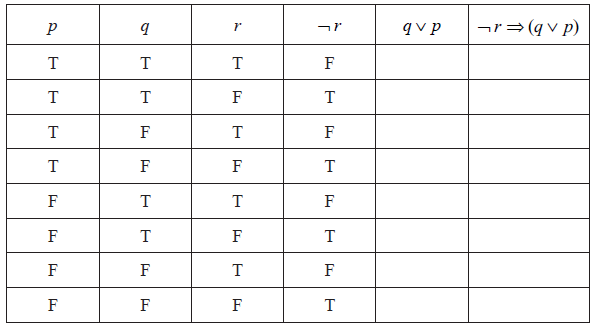 [2]
[2]
The argument \(\neg r \Rightarrow (q \vee p)\) is invalid. State the reason for this.[1]
Answer/Explanation
Markscheme
If Alex does not play the flute then he is either a scientist or from Uruguay. (A1)(A1)(A1) (C3)
Note: Award (A1) if… then, correct (A1) antecedent, (A1) correct consequent.
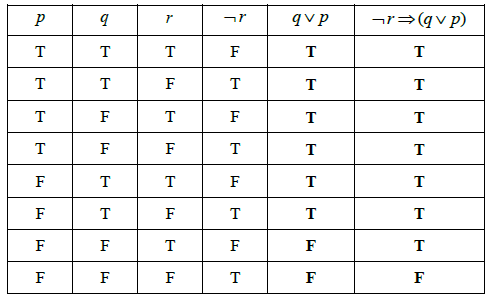 (A1)(A1) (C2)
(A1)(A1) (C2)
Not all entries in the final column are T. (R1) (C1)
Question
Consider the following statements about the quadrilateral ABCD
\(q:\) ABCD has four equal sides \(s:\) ABCD is a square
Express in words the statement, \(s \Rightarrow q\) .[2]
Write down in words, the inverse of the statement, \(s \Rightarrow q\) .[2]
Determine the validity of the argument in (b). Give a reason for your decision.[2]
Answer/Explanation
Markscheme
If ABCD is a square, then ABCD has four equal sides. (A1)(A1) (C2)
Note: Award (A1) for if… then, (A1) for propositions in the correct order.
If ABCD is not a square, then ABCD does not have four equal sides. (A1)(A1) (C2)
Note: Award (A1) for if… then, (A1) for propositions in the correct order.
Not a valid argument. ABCD may have 4 equal sides but will not necessarily be a square. (It may be a rhombus) (A1)(R1) (C2)
Note: Award (R1) for correct reasoning, award (A1) for a consistent conclusion with their answer in part (b).
It is therefore possible that (R1)(A0) may be awarded, but (R0)(A1) can never be awarded.
Note: Simple examples of determining the validity of an argument without the use of a truth table may be tested.

